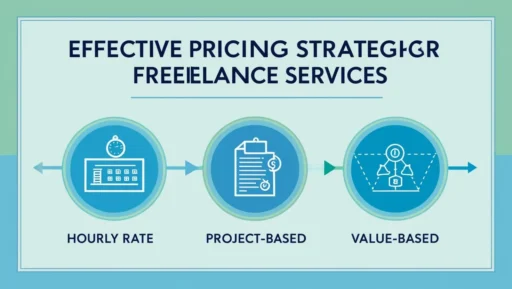Understanding the Importance of Strategic Pricing
Setting the right price for your freelance services is one of the most powerful and strategic decisions you will make for your business. It is the engine that drives your income, but it does so much more than that. Your pricing dictates the quality of clients you attract, influences their perception of your value, and ultimately determines the long-term sustainability and enjoyment of your career.
Pricing too low is a fast track to burnout; it attracts demanding, low-budget clients and forces you to work endless hours for minimal gain. Pricing too high without justification can make it difficult to gain traction, especially in the beginning. This guide provides actionable strategies to help you move beyond guesswork and confidently determine your freelance rates, allowing you to maximize your income, attract better clients, and get paid what you are truly worth.
The Core Ingredients of Your Price
Before you can pick a number, you must understand the key factors that influence it. A fair price is a thoughtful blend of your value, market realities, and your business needs.
- Your Experience and Skill Level: This is the most significant factor. A seasoned professional with a decade of experience and a portfolio brimming with successful case studies can and should charge a premium. As your skills, efficiency, and portfolio grow, your prices should climb a “value ladder” alongside them.
- Market Demand and Industry Standards: Rates vary dramatically between fields. A web developer’s hourly rate will differ from a copywriter’s or a graphic designer’s. Research the current market rates for your specific industry and niche to ensure you are positioned competitively.
- Project Complexity and Scope: A simple, five-page brochure website is not the same as a complex e-commerce store with hundreds of products. The more specialized, time-consuming, or technically difficult a project is, the higher the price it justifies.
- Client Type and Budget: A Fortune 500 corporation has a vastly different budget and perceives value differently than a local non-profit or a bootstrapped startup. Tailor your pricing and proposals to the type of client you are targeting.
Pricing Models: Which Should You Choose?
There are several ways to structure your pricing. The best model often depends on the project’s nature and your client’s needs.
1. Hourly Rate
Charging by the hour is straightforward and ideal for ongoing projects or tasks where the scope is flexible or unpredictable.
- Pros: Guarantees you are paid for all your time, including extra revisions or meetings. It’s transparent for the client.
- Cons: It can penalize efficiency—the faster and better you get, the less you earn for the same task. It can also create anxiety for clients who fear a runaway budget.
2. Project-Based Rate
You charge a single, flat fee for a clearly defined project. This is the most common and often preferred model for projects with a predictable outcome.
- Pros: The client loves the predictability of a fixed cost. It rewards you for efficiency; if you complete the project faster than estimated, your effective hourly rate increases.
- Cons: This model requires an ironclad scope of work outlined in your contract. Without it, you are highly vulnerable to “scope creep”—doing extra work for free.
3. Retainer Agreements
A client pays you a fixed fee each month for a set amount of work or guaranteed access to your expertise.
- Pros: Provides you with predictable, stable monthly income. It’s excellent for fostering long-term client relationships.
- Cons: Requires careful management to ensure you are not consistently working more hours than the retainer covers.
4. Value-Based Pricing (Advanced)
This advanced strategy bases your price on the value and ROI you deliver to the client’s business, not the hours you work.
- Example: If you are a copywriter hired to write a sales page, and you can reasonably project that your work will generate $100,000 in new revenue for the client, a fee of $5,000-$10,000 (5-10% of the value created) is easily justified. This model requires deep industry knowledge and a high level of trust with the client.
How to Calculate Your Absolute Minimum Rate
This calculation will give you your “survival rate”—the absolute minimum you must charge to keep your business afloat. This is your floor, not your target rate.
- Calculate Your Total Annual Costs: Add up your annual personal living expenses (rent, food, utilities, etc.) and your annual business expenses (software, hardware, marketing, health insurance, professional development).
- Add Your Desired Profit: What do you want to save or reinvest? A good starting point is 20% of your total costs.
- Factor in Taxes: Set aside roughly 30% of your total income target for taxes. So, multiply your costs + profit by 1.3. This is your total annual income goal.
- Estimate Your Annual Billable Hours: A 40-hour work week is not 40 billable hours. A full-time year has 2,080 hours. Subtract weekends, a few weeks for vacation and sick days, and at least 10 hours per week for non-billable admin and marketing tasks. A realistic number is often between 1,000-1,200 billable hours per year.
- Do the Math: (Total Annual Income Goal) / (Annual Billable Hours) = Your Minimum Hourly Rate
Handling Rate Negotiations with Confidence
Negotiation is a normal part of business. When a client pushes back on your price, don’t panic.
- Don’t Default to a Discount: When a client says, “That’s more than our budget,” your first response should be, “I understand. The price I’ve quoted reflects the full scope of work we discussed. To help meet your budget, what parts of the project would you be open to removing or simplifying?” This reframes the conversation from devaluing your work to adjusting the scope.
- Justify Your Value: Confidently explain what the client is getting for their investment—your expertise, your reliable process, and the results you will deliver.
- Know When to Walk Away: A client who fights you tooth and nail on price before the project even starts is often a major red flag. It’s better to walk away from a bad-fit project than to be underpaid and undervalued.
Avoiding Common Pricing Mistakes
- Underpricing Due to Insecurity: Trust the rate you calculated. Your price is based on data, not feelings.
- Forgetting to Account for Overheads: Your rate is not an employee’s wage. It must cover your taxes, insurance, software, and non-billable time.
- Offering Vague Scopes: Always get the full project details in writing. Extra work must always equal extra pay.
Conclusion: Confidence is Your Greatest Pricing Tool
Setting your freelance rates is a blend of art, science, and self-worth. Your prices are a direct reflection of your professionalism, your market knowledge, and the tangible results you deliver. Revisit your pricing strategy at least once a year, and never be afraid to charge what you are truly worth. A confident pricing strategy will not only provide you with financial stability but will also attract respectful clients who are happy to invest in your expertise.
“Knowing how much do freelancers really make can give you a good benchmark.”

